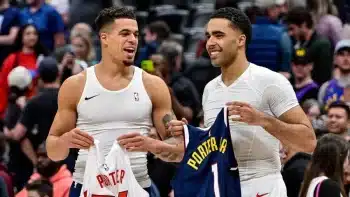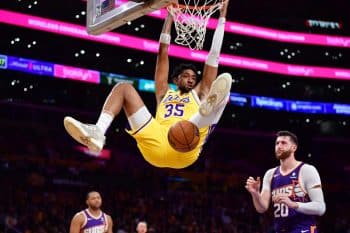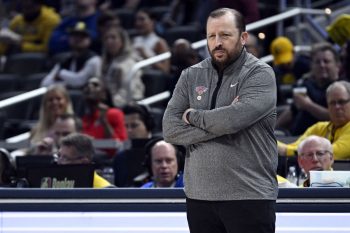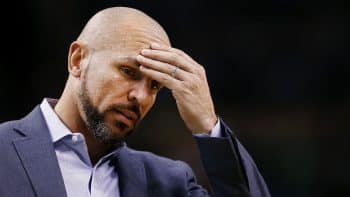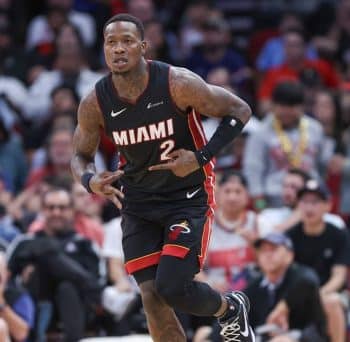NBA
NBA PM: Why Isn’t Anfernee Simons Played More?

In the modern NBA, the pathway of going straight from high school to the league has been abolished, forcing the overwhelming majority of talented young basketball players to play in the NCAA. Most people think that it is required for a high school basketball prospect to play at the collegiate level if they want to succeed in the NBA, but that is not always the case. Since there has to be a year elapsed after graduating from high school to enter the NBA Draft, some teens have found a loophole. Anfernee Simons is one of the latest examples of this, as he entered the 2018 draft following a post-grad year at IMG Academy. Simons would end up making a smart decision as he would get picked 24th overall by the Portland Trailblazers.
In his first season, Simons rode the end of the bench only playing in 20 games as the Blazers chose to ease him into the league since he didn’t have college experience under his belt. Simons came in as a very raw prospect full of upside, with lightning speed and a good handle of the ball, while having the physical tools to develop into a solid defender on opposing guards. While he averaged a meager 3.8 points per game across the 20 contests he played in, he let the league know why he was ranked the ninth-best prospect for the 2018 high school class by ESPN, in the last game of the season against the Sacramento Kings.
In this contest, Simons went off. He scorched the Kings for 37 points on 13-21 shooting while hitting 7-11 of his three-point attempts to go along with 6 rebounds and 9 assists. This game was not very close for the majority of it and at one point in the second quarter, the Blazers were down 70-45, per Basketball-Reference. The sweet-shooting stroke off the dribble, that many people had doubted Simons could consistently provide, was put on display as he led the Blazers reserves to a comeback win. It would be one thing to say that since Simons played the whole 48 minutes of the game, he should have been expected to go off, but when it’s known that he led a starting five of Skal Labissière, Jake Layman, Gary Trent Jr., and Meyers Leonard to a win, it’s more impressive.
After improving his numbers and showing more confidence at the NBA level, it was interesting to see that Simons was much of an afterthought for the Blazers at the bubble. He did have a 13 point, 4 steal performance in Game 5 against the Los Angeles Lakers, but he got most of his time in meaningless minutes. Besides that game, he only had one other game with more than 3 points. The team had elected to use Trent Jr. as their go-to bench guard forcing Simons into a smaller role than his play may have deserved.
This sudden refusal to play Simons has carried over into this season as through the team’s first 52 games, he has played in 45 while averaging 16.2 minutes per game, a downgrade from last year where he played in 20.7 minutes per game. It’s puzzling that coach Terry Stotts would ease a young player like Simons into the team, build his confidence, and then instead of elevating him further to maybe the Sixth man or a prominent bench role, he goes further down the ladder. According to an article by Sports Illustrated, Simons has been the odd man out with McCollum returning from injury, as well as Gary Trent Jr. outperforming him in the minutes he played. Now, with the trade of Trent Jr. for Norman Powell, Simons continues to be further down the rotation for the Blazers.
The thing that hinders Simons and the Blazers from further progress is the lack of height in their star guards. Neither Damian Lillard nor McCollum is tall enough to play small forward against a natural forward, and new acquisition Norman Powell is only 6-foot-4 as well. The Blazers wanted Trent Jr. to be the guy that could play the 3 consistently and allow them to mess around with their rotation, but in the games where he played minutes at the forward position, he proved he was incapable of guarding opposing forwards. Swapping Trent Jr. for Powell doesn’t make much of a difference for Simons’ ascension to a prominent role, and only keeps him where he is.
In his more limited role this season, Simons is averaging just .5 points under what he did in almost 21 minutes per game last year. He has taken about 70 percent of his shots from the three-point range, improving his three-point percentage to 41.5 percent on the season. The Blazers are a good three-point shooting team that can take a hold of the game at any moment with their shooting, but it’s confusing as to why they wouldn’t use one of their best shooters more often.
The question that has slowly started to circulate around the Blazers is are they good enough to win a title with Lillard as the leader? It has yet to be answered, but with his play this year and this past season, he has more than shown that he can be the best player on a good team, but can he take that next step as a superstar? He’ll need a lot of help from his sidekick McCollum, future Hall-of-Famer Carmelo Anthony, Jusuf Nurkic, and the newly-acquired Powell if they wish to have any chance at competing for a title.
The demotion of Simons is very troubling but at this point three years in, it could be likely that the Blazers just aren’t the team for the explosive guard to break out on. What team wouldn’t want to take a chance on a 21-year-old guard full of speed and explosiveness to go along with a sweet shooting stroke that has improved in his time in the NBA? Simons has proved that when thrown into the big role he can perform, and when thrown into the spotlight of the dunk contest, he took over. Still with all of his promise and potential he finds himself warming the bench most nights. According to Spotrac, he’s under contract until 2023 where he then becomes a restricted free agent, so the most likely departure of Simons would have to come by trade.
It is clear that Simons is going to be an NBA player for years to come, but by the day it seems that it may not be with the team that drafted him. There are plenty of other teams who would love to add him into their rotation and develop him further, so keep an eye on trade offers for the promising young player in the offseason and the future.
